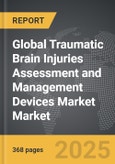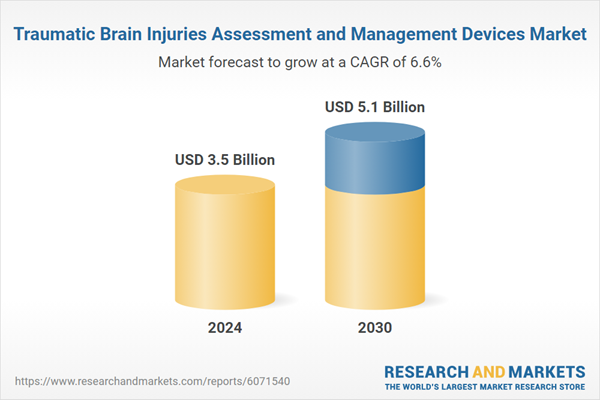Traumatic Brain Injuries (TBI) Assessment and Management Devices Market Trends & Drivers Summarized
How Are TBI Assessment and Management Devices Transforming Neurosurgical and Rehabilitation Practices?
Traumatic brain injuries (TBIs) are a major public health concern, with millions of cases reported annually due to accidents, sports injuries, and military-related trauma. Effective diagnosis and management of TBIs are crucial to preventing long-term cognitive impairment and disability. Traditional assessment methods, such as CT scans and neurological exams, are being complemented by advanced diagnostic tools, including point-of-care biomarkers, portable EEG devices, and AI-powered imaging analysis. Additionally, innovations in neurorehabilitation devices, such as brain-computer interfaces (BCIs) and transcranial stimulation therapies, are improving recovery outcomes. However, challenges such as delayed diagnosis, variability in symptom presentation, and limited access to specialized neurotrauma care remain barriers to effective TBI management. As neuroscience research advances, how will new technologies improve TBI diagnosis, monitoring, and rehabilitation?What Technological Innovations Are Advancing TBI Assessment and Management?
Breakthroughs in TBI diagnostics and rehabilitation focus on real-time brain activity monitoring, AI-assisted imaging, and neurostimulation therapies. Portable rapid-detection devices using blood-based biomarkers are enabling early diagnosis, reducing the need for invasive procedures. AI-powered CT and MRI analysis tools are improving lesion detection, helping clinicians assess injury severity more accurately. Virtual reality (VR)-based neurorehabilitation platforms are enhancing cognitive and motor function recovery, making rehabilitation more engaging and effective. Additionally, transcranial direct current stimulation (tDCS) and non-invasive brain stimulation therapies are accelerating neural regeneration and improving long-term outcomes for TBI patients.Why Is the Demand for TBI Assessment and Management Devices Increasing?
The rising incidence of TBIs due to accidents and contact sports, increasing military-related brain injuries, and growing awareness of post-concussion syndrome (PCS) are driving demand for advanced assessment and rehabilitation solutions. The expansion of telemedicine and remote monitoring technologies is further improving access to TBI diagnostics and rehabilitation services. Additionally, advancements in wearable neuro-monitoring devices are enabling real-time brain activity tracking, facilitating early intervention and personalized treatment plans.What Factors Are Driving the Growth of the TBI Assessment and Management Devices Market?
The market is expanding due to increasing investments in neurotrauma research, rising adoption of AI-powered diagnostic tools, growing demand for non-invasive neurorehabilitation therapies, and expanding applications of telemedicine in brain injury management. As technology continues to enhance early diagnosis and personalized treatment strategies, TBI assessment and management devices are expected to play a crucial role in improving patient outcomes and reducing long-term disabilities.Report Scope
The report analyzes the Traumatic Brain Injuries Assessment and Management Devices market, presented in terms of market value (US$). The analysis covers the key segments and geographic regions outlined below:- Segments: Devices (Imaging Devices, Monitoring Devices); Technique (Intracranial Pressure Monitoring, Partial Pressure of Oxygen in Brain Tissue); End-Use (Hospitals, Diagnostic Centers, Others).
- Geographic Regions/Countries: World; United States; Canada; Japan; China; Europe (France; Germany; Italy; United Kingdom; Spain; Russia; and Rest of Europe); Asia-Pacific (Australia; India; South Korea; and Rest of Asia-Pacific); Latin America (Argentina; Brazil; Mexico; and Rest of Latin America); Middle East (Iran; Israel; Saudi Arabia; United Arab Emirates; and Rest of Middle East); and Africa.
Key Insights:
- Market Growth: Understand the significant growth trajectory of the Imaging Devices segment, which is expected to reach US$3.4 Billion by 2030 with a CAGR of a 7.8%. The Monitoring Devices segment is also set to grow at 4.5% CAGR over the analysis period.
- Regional Analysis: Gain insights into the U.S. market, valued at $945.6 Million in 2024, and China, forecasted to grow at an impressive 10.6% CAGR to reach $1.1 Billion by 2030. Discover growth trends in other key regions, including Japan, Canada, Germany, and the Asia-Pacific.
Why You Should Buy This Report:
- Detailed Market Analysis: Access a thorough analysis of the Global Traumatic Brain Injuries Assessment and Management Devices Market, covering all major geographic regions and market segments.
- Competitive Insights: Get an overview of the competitive landscape, including the market presence of major players across different geographies.
- Future Trends and Drivers: Understand the key trends and drivers shaping the future of the Global Traumatic Brain Injuries Assessment and Management Devices Market.
- Actionable Insights: Benefit from actionable insights that can help you identify new revenue opportunities and make strategic business decisions.
Key Questions Answered:
- How is the Global Traumatic Brain Injuries Assessment and Management Devices Market expected to evolve by 2030?
- What are the main drivers and restraints affecting the market?
- Which market segments will grow the most over the forecast period?
- How will market shares for different regions and segments change by 2030?
- Who are the leading players in the market, and what are their prospects?
Report Features:
- Comprehensive Market Data: Independent analysis of annual sales and market forecasts in US$ Million from 2024 to 2030.
- In-Depth Regional Analysis: Detailed insights into key markets, including the U.S., China, Japan, Canada, Europe, Asia-Pacific, Latin America, Middle East, and Africa.
- Company Profiles: Coverage of players such as Albany Medical Center, Ascension St. John Hospital, Banner University Medical Center Phoenix, Baylor University Medical Center, Bellevue Hospital Center and more.
- Complimentary Updates: Receive free report updates for one year to keep you informed of the latest market developments.
Some of the 41 companies featured in this Traumatic Brain Injuries Assessment and Management Devices market report include:
- Abbott
- Advanced Brain Monitoring, Inc.
- Amarantus BioScience Holdings
- BRAINBox Solutions
- BrainScope Company, Inc.
- Ceribell, Inc.
- Compumedics Limited
- Elekta AB
- GLIA Diagnostics
- Head Diagnostics
- InfraScan, Inc.
- Integra LifeSciences
- Medicortex Finland Oy
- NanoDx, Inc.
- Natus Medical Incorporated
- Neuren Pharmaceuticals Ltd.
- Nexalin Technology
- Nihon Kohden Corporation
- NovaSignal Corporation
- Oxygen Biotherapeutics Inc.
- QuesGen Systems, Inc.
- Raumedic AG
This edition integrates the latest global trade and economic shifts into comprehensive market analysis. Key updates include:
- Tariff and Trade Impact: Insights into global tariff negotiations across 180+ countries, with analysis of supply chain turbulence, sourcing disruptions, and geographic realignment. Special focus on 2025 as a pivotal year for trade tensions, including updated perspectives on the Trump-era tariffs.
- Adjusted Forecasts and Analytics: Revised global and regional market forecasts through 2030, incorporating tariff effects, economic uncertainty, and structural changes in globalization. Includes historical analysis from 2015 to 2023.
- Strategic Market Dynamics: Evaluation of revised market prospects, regional outlooks, and key economic indicators such as population and urbanization trends.
- Innovation & Technology Trends: Latest developments in product and process innovation, emerging technologies, and key industry drivers shaping the competitive landscape.
- Competitive Intelligence: Updated global market share estimates for 2025, competitive positioning of major players (Strong/Active/Niche/Trivial), and refined focus on leading global brands and core players.
- Expert Insight & Commentary: Strategic analysis from economists, trade experts, and domain specialists to contextualize market shifts and identify emerging opportunities.
Table of Contents
Companies Mentioned (Partial List)
A selection of companies mentioned in this report includes, but is not limited to:
- Abbott
- Advanced Brain Monitoring, Inc.
- Amarantus BioScience Holdings
- BRAINBox Solutions
- BrainScope Company, Inc.
- Ceribell, Inc.
- Compumedics Limited
- Elekta AB
- GLIA Diagnostics
- Head Diagnostics
- InfraScan, Inc.
- Integra LifeSciences
- Medicortex Finland Oy
- NanoDx, Inc.
- Natus Medical Incorporated
- Neuren Pharmaceuticals Ltd.
- Nexalin Technology
- Nihon Kohden Corporation
- NovaSignal Corporation
- Oxygen Biotherapeutics Inc.
- QuesGen Systems, Inc.
- Raumedic AG
Table Information
| Report Attribute | Details |
|---|---|
| No. of Pages | 368 |
| Published | December 2025 |
| Forecast Period | 2024 - 2030 |
| Estimated Market Value ( USD | $ 3.5 Billion |
| Forecasted Market Value ( USD | $ 5.1 Billion |
| Compound Annual Growth Rate | 6.6% |
| Regions Covered | Global |









